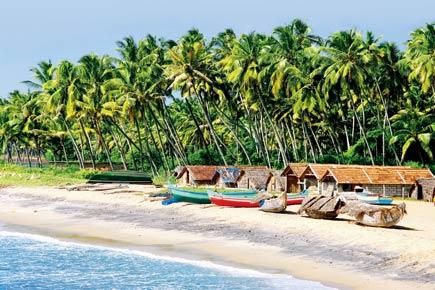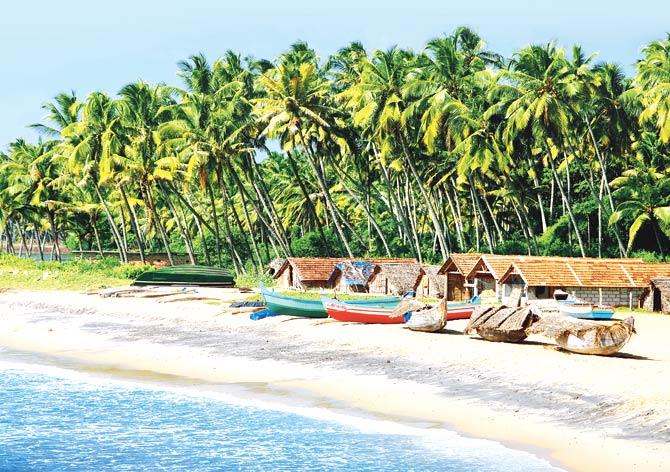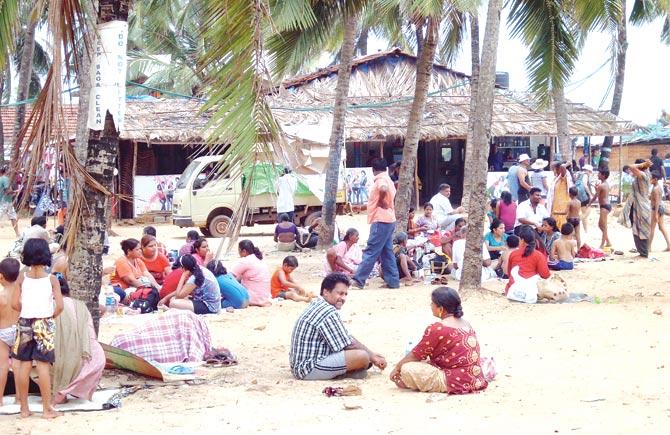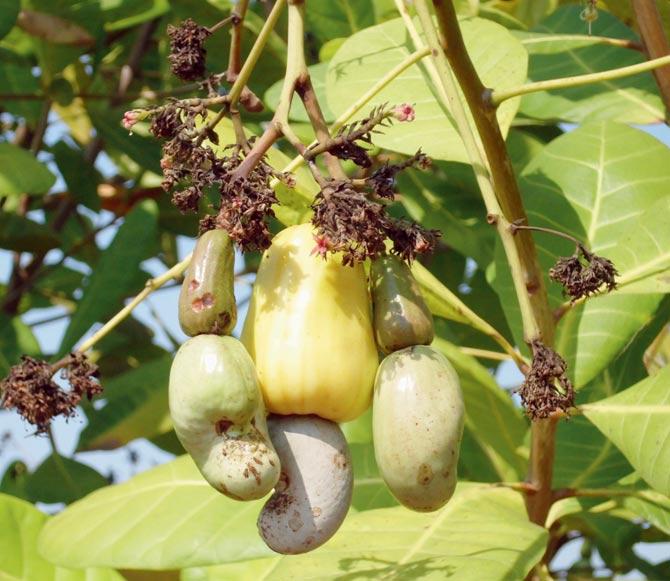... and the livin’ is easy for Mumbaikars who make their way to Goa for a number of different reasons, as varied as a slice of nostalgia, to the more prosaic – to keep encroachers off their property

A typical Goa fishing village make a picture postcard setting and exudes a sense of old world charm. Summer is when Goans outside flock here for a slice of the life they left behind
It is summer and at this time, Goans in Mumbai head for their homes in Goa — those who can, that is. There are many reasons for this, but the biggest surely is the leisurely Goan way of life. Nobody can tell accurately when this tradition of Goans returning to Goa during the summer months started (only the tourists come to Goa during Christmas in December), but there is a good possibility that it began with the ‘Simla Beat Contest’, a music festival which used to be held on Calangute beach, north Goa, starting in 1965.
ADVERTISEMENT
 Vistas: A typical Goa fishing village make a picture postcard setting and exudes a sense of old world charm. Summer is when Goans outside flock here for a slice of the life they left behind
Vistas: A typical Goa fishing village make a picture postcard setting and exudes a sense of old world charm. Summer is when Goans outside flock here for a slice of the life they left behind
In 1961, Goa had just been liberated from 450 years of Portuguese rule by the Indian armed forces, drawing global attention to the tiny territory as Portugal was part of NATO. While the Portuguese had to pack their bags and depart, many Goans, because of lack of employment opportunities in newly-freed Goa started migrating to Mumbai and other places for jobs creating a huge diaspora, especially of the Goan Catholics.
Hello hippies
Coincidentally, the hippies a product of the counter-culture revolution happening in the West which resulted in the creation of rock music and other things in the early 1960s, soon descended on the pristine white sands of Calangute Beach, and, before you could say Goa, introduced nude sun-bathing, acid parties and the good vibrations of love and peace, bringing a counter-culture to Goa. It was a heady atmosphere of freedom, and one thing lead to another.

RIGHT NOTES: The music of the state has been immortalised in many Bollywood songs
Somebody came up with the idea of having a western pop-rock music festival, and so the ‘Simla Beat Contest’ was born in 1965 on the terrace of Royal Hotel right on the then pristine beach in Calangute. (Simla was the name of a non-filter cigarette brand). It lasted from 1965 to 1973 and with the hippies pouring in from America and Europe, the music fest, in the spirit of Woodstock, mirrored the great psychedelic music and flower power movement in the West and became a great attraction.

BY THE SEA: The land of sun, sand, sea and surf, is a big lure during summer but this is for a variety of reasons
The contest saw top Western music bands mostly comprising Goans, from all over the country compete for the top honour, and many of them like Remo Fernandes (a student of architecture in what was then Bombay), Steve Sequeira and others went on to become famous musicians, while there were those who were inspired to start their own bands. Somewhere in the mix were also the hippie musicians. It was the mother of all music shows. Many of the Goans migrating to Mumbai and other places were musicians, and the great era of Goan musicians in Bollywood was also happening at around this time.

FUN FOOD: Cashews are a favourite for Goans
Tito Goes Proenca, now a builder, was a small boy then. He says, “At that time, there was no other entertainment, so this was a major event. It was the biggest show of the year. We had our summer holiday home at Calangute and we would make sure we were there for the beat shows,” he recalls. “We were inspired by the beat shows and started our own band,” he says nostalgically.
It also became fashionable for Goans in Goa along with their relatives from outside, down for their holidays, to head for salt water baths during the summer at Calangute Beach. Some say this was done to ogle the nude hippies, others say it was to take part in the general revelry happening around the beat shows, Yet others state that it was because a salt water bath is good for health. “Everybody from Goa, even from Salcete (south Goa), would come and it was like the whole Goan family would be there,” says Justin Lobo, then a Calangute teenager. “All Bombay Goans, seamen, Goans working in the Gulf and other countries, would come there with their families and relatives in Goa. Everybody would share their food and stuff,” says Joseph Sequeira, a member of the Calangute village Panchayat adding, “I remember one hippie family would come and stay for two months every year and they would rent out a room in our house for Rs 150 per month.”
“They would come and stay for 10-15 days. The guest-house culture in Calangute started in those days,” remembers Clara Fernandes, sarpanch of Calangute, who was married in 1972, a few years after the beat shows started.
To the beat
A band called Beat Four won most of the contests held from 1965 to 1973. Thomas Menezes, now a businessman, played the guitar with the Beat Four. "We won almost every year. First we used to play on the terrace of Royal Hotel. Thousands of people would gather on the beach and downstairs to hear the music which used to go up to 3 am, unlike now when you have to wind up by 11 pm. Around 14-15 groups used to take part in the contest,” he recalls. Ralin Sequeira, another musician, recalls the time the Brood of Vipers won the contest. “They won because they introduced a new form of music called Acid Rock. They were fantastic. Also I remember the Spiders were really good.”
If there ever was such a thing as the ‘Great Goan Picnic’, it was during the time of the ‘Simla Beat Contest’. The festival grew bigger and bigger every year as more and more Goans, especially from Mumbai, flocked to Goa to be a part of this unique celebration. Somehow, it also became a tradition to visit Goa during the summer holidays and Calangute beach was the must-visit place.
The beat show though, was not the only thing which drew back Goans to Goa. Like they say, you can take the Goan out of Goa, but you can’t take Goa out of the Goan. Just like with all other communities and cultures, Goans too yearn for Goa, the Goa that exists in their imagination and memories, to connect with their extended families and communities, to partake in what it means to be a Goan. And so it is with the Goans from Mumbai who try and make their annual pilgrimage back home around summertime.
This is also the time when some of those quintessential Goan things make their appearance.
Topping the list, of course, is cashew feni, that unique Goan tipple. The cashew apples ripen during summertime and many village hamlets are redolent with the scent of feni being distilled or cashew nuts being roasted. Many Goans staying in Goa avoid cashew feni because most of what is sold locally is adulterated hooch. But it is the Goans who come back during summer who determinedly find their way to a local distillery for a glass of ‘neero’, fresh cashew juice, and then take away a bottle or two of fresh ‘urrack’, the first distillation of the cashew juice which is only available during summertime. The second distillation produces ‘feni’.
Back home
Coming back from a crowded city like Mumbai to village life in Goa means returning to the arms of nature, which in itself is a highly reinvigorating experience. Most come back to their family homes, around which will be a small variety of fruiting plants like mangoes which also ripen during this time of the year. Then there are the many seasonal summer fruits which grow wild everywhere you go.
The new generation of Goans born to those Goan migrants to Mumbai and elsewhere, many of them born out of marriages with non-Goans, also yearn for that Goan experience, many of them finally getting to sample authentic Goan food and other delicacies. Agnelo Fernandes, a Vakola resident who migrated to Mumbai in the early 1990s, makes it a point to visit some of the best Goan food restaurants while in Goa. “It is the taste!” he exclaims when asked why. The unique taste of the authentic Goan masalas. After every summer visit to Goa, he returns with two gallons of ‘urrack’ to make life easier for him back in Mumbai.
While the ‘Simla Beat Contest’, widely regarded as Goa’s very own version of the Woodstock Music Festival, died down in 1973, it was followed by the Four Square Beat Shows for a few years before the beach music festivals stopped. By then, a number of other beat shows had bloomed in various parts of Goa, and the famous acid parties of the hippies had become a regular big draw a little north of Calangute, in Anjuna-Vagator.
Over the decades, the acid parties stopped featuring live musicians and recorded music being played by DJs became the norm. The parties themselves came to be known as raves, once again reflecting the trend in the West. The biggest and best raves are now in Morjim, a little to the north of Anjuna.
But these acid parties and raves are not quite the same thing as the great social gatherings of Goans of the ‘Simla Beat Contest’ days. They are more touristy affairs. For the last decade or so, there has been a growing lament about the erosion of Goan culture and many new festivals have cropped up around the promotion of Goan culture and heritage, offering a glimpse of the Goa that once was, to the new generation. All of them are held in the summer months so that the Goans who come back to Goa can attend them. The mega Goa Food and Cultural Festival, hosted by the Goa government’s tourism department (yes, it also tries to attract Goans back to Goa) was held a couple of weeks ago. There are many other festivals held around this time, like the Konkan Fruit Festival, the Cashew and Coconut Festival and others.
Reaching for the roots
The idea is to reconnect Goans with their roots. With many non-resident Goans yearning for exactly this experience, the festivals sees huge crowds. Taking a cue from this, recently, some residents from Calangute where it had all started half a century ago decided to, bring back those glory days, as they say. Last month end they held a ‘Family Entertainment and Musical Beatshow’, hoping to recapture the magic of the ‘Simla Beat Contest’ days, and also to bring back Goans to Calangute beach. Following the huge popularity of Calangute after the beat shows of the late 1960s and 1970s, there had been a deluge of domestic and foreign tourists, and in the last couple of decades it had practically degenerated into a hotbed of sleaze, giving it a bad name. Calangute became a no-go place for Goans.
“We want to call back Goans to Calangute, especially Goans from Mumbai who have come down for their summer holidays. We request all Goans, Catholics, Hindus, Muslims and others to come to Calangute and meet with each other and enjoy each other’s company just like in the old days,” Joseph Sequeira, a resident who has been controlling the affairs of the Calangute Panchayat, and the driving force behind the new festival, said.
Curious to see what the hullabaloo was all about, many turned up to watch Goa’s nightingale called Lorna sing some famous Konkani songs, and watch lively dancers. Yet, it was not quite like the ‘Simla Beat Contest’ days. A Goan who had also been to the ‘Simla Beat Contest’ shows said, “Those days are gone. This is also nice in its own way, but how can you bring back the past?”
On the flipside, many non-resident Goans, who visit the land of their ancestors, only to find it vastly different from what they thought it would be, now do so for another simpler reason, which is to prevent encroachers on their properties and to sell the properties. That is because outside of these festivals, except in a handful of villages, they find that there is not much of that old Goan culture left. The tourism boom has created a vibrant property market, and these non-resident Goans find that there are many takers for their old homes and properties lying idle.
Goan families which have splintered over the years try to do a bit of bonding. For Shraddha Chodankar, a dentist in north Goa, whose Pune-based sister comes calling for a few days every summer, those few days are also a time to take a break from her hectic schedule and turn tourist. “We simply drive around Goa and visit all the beaches, talk about all the events which have happened to us, eat some good food and enjoy ourselves.”
 Subscribe today by clicking the link and stay updated with the latest news!" Click here!
Subscribe today by clicking the link and stay updated with the latest news!" Click here!






